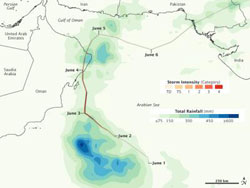NASA'S TRMM Satellite provides rainfall estimate for Cyclone Phet

This TRMM satellite rainfall estimate map showed Cyclone Phet\'s heaviest rainfall (600 or more millimeters/23.6 or more inches) occurred over open waters of the Arabian Sea (blue) Northeast Oman received as much as 450 millimeters (17.7 inches), while Pakistan received between 150-300 millimeters/ 5.9-11.8 inches. The colored line indicates storm track and intensity. Credit: NASA /Jesse Allen<br>
TRMM satellite rainfall data estimated Cyclone Phet's heaviest rainfall (600 or more millimeters/23.6 or more inches) occurred over open waters of the Arabian Sea. One area of northeast Oman received as much as 450 millimeters (17.7 inches), while Pakistan received between 150-300 millimeters/ 5.9-11.8 inches as Phet made landfall there this past weekend.
NASA's Jesse Allen created a rainfall image is based on data from the Multi-satellite Precipitation Analysis (MPA) produced at NASA's Goddard Space Flight Center in Greenbelt, Md. The image showed both rainfall amounts and the storm track for Phet from May 31 to June 6, 2010. The MPS analysis estimates rainfall by combining measurements from many satellites and calibrating them using rainfall measurements from the Tropical Rainfall Measuring Mission (TRMM) satellite.
Tropical Cyclone Phet brought not just strong winds but also heavy rains to the Arabian Sea, the Arabian Peninsula, and the coast of Pakistan in late May and early June. Phet reached its greatest intensity off the coast of Oman on June 3. After making landfall in Oman, Phet dissipated somewhat, but remained organized enough to move back over the Arabian Sea toward Pakistan.
Media Contact
More Information:
http://www.nasa.govAll latest news from the category: Earth Sciences
Earth Sciences (also referred to as Geosciences), which deals with basic issues surrounding our planet, plays a vital role in the area of energy and raw materials supply.
Earth Sciences comprises subjects such as geology, geography, geological informatics, paleontology, mineralogy, petrography, crystallography, geophysics, geodesy, glaciology, cartography, photogrammetry, meteorology and seismology, early-warning systems, earthquake research and polar research.
Newest articles

Silicon Carbide Innovation Alliance to drive industrial-scale semiconductor work
Known for its ability to withstand extreme environments and high voltages, silicon carbide (SiC) is a semiconducting material made up of silicon and carbon atoms arranged into crystals that is…

New SPECT/CT technique shows impressive biomarker identification
…offers increased access for prostate cancer patients. A novel SPECT/CT acquisition method can accurately detect radiopharmaceutical biodistribution in a convenient manner for prostate cancer patients, opening the door for more…

How 3D printers can give robots a soft touch
Soft skin coverings and touch sensors have emerged as a promising feature for robots that are both safer and more intuitive for human interaction, but they are expensive and difficult…




















